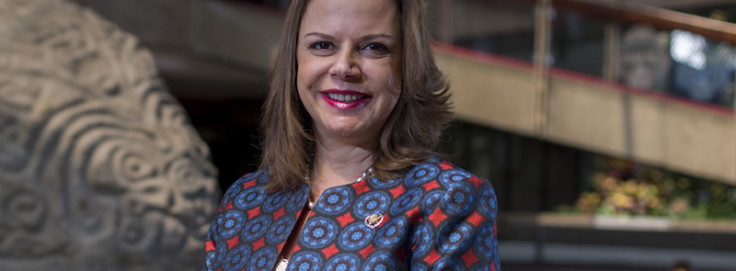
Search
‘Involving the Private Sector Is the Right Idea for Ramping Up the Fight against Poverty’

Dimensions spoke with Ana Helena Chacón Echeverría, Second Vice President of Costa Rica, about collaborating with the private sector and how the government is using the national Multidimensional Poverty Index. This indicator, she claims, will make the distribution of public resources more efficient, and the hope is that it will also encourage transparency in institutional activities.
Why has the government of Costa Rica decided to measure poverty multidimensionally?
In this administration, we believe that a change of focus in the fight against poverty was necessary. We saw the need to include a multidimensional measure that allowed a comprehensive view of poverty and identified its causes in the national context.
This measure complements the traditional income method and provides a more precise analysis of poverty. Both measures will be used for analysis and social policy.
Why was this done in collaboration with the private sector? How has this alliance benefitted the government?
This administration prioritised the coordination and articulation of programmes at public institutions and emphasised the shared responsibility of other social actors at an intersectoral level.
A tripartite alliance was established with the government of Costa Rica, OPHI, and Horizonte Positivo [1], with the objectives of implementing the Multidimensional Poverty Index in Costa Rica (MPI-CR); promoting joint research; and developing tools for the measurement, design, and analysis of public policies.
Horizonte Positivo has been a great ally in this effort. With their participation, the official launch of the MPI-CR took place in October 2015, with the goals of supporting the efficient targeting of resources, maximising the impact of these resources, and encouraging transparency of institutional activities. This alliance is one of the reasons that Costa Rica is the country that calculated its MPI in the shortest time and the only one in the world to do so with the support of the private sector.
The MPI-CR is being used to develop departmental budgets. What was the political-technical process that enabled this to take place?
The process was led by a commission that included representatives from the Presidential Social Council Advisory Team, Ministry of Planning (Mideplan), Ministry of Finance, Social Development and Family Allowances Fund (Fodesaf), and the Horizonte Positivo Association.
The objective was to incorporate the results of the MPI-CR as the main criteria for setting goals. This was done in order to elucidate the regional distribution of poor households that are deprived in the indicators relevant to each institution. It was also to ensure that the investment of resources is based on evidence, allocating the appropriate amount of required support to each region.
In a first stage, some institutions and programmes were chosen for their ability to impact the results of the MPI-CR. Training was provided to senior, including vice ministers and directors, and mid-level officials from different institutions to highlight the effects of using the MPI-CR in budget allocation and how to implement it.
This process had the political support of the Executive Cabinet through presidential directives that highlight the use of the MPI-CR as a useful tool to guide the distribution of resources.
“We encourage countries that are embarking on the MPI process not to use it only to understand poverty but also as a technical tool to improve the quality of social policies.”
Based on this initial work, and with the aim of institutionalising this process, there has been an effort to include the MPI-CR as a standard tool for setting goals and for budget distribution in the guidelines issued by the Ministry of Finance and the Ministry of Planning that institutions must follow when developing their budgets.
For 2018, 18 programmes from 14 institutions have been selected to use the MPI-CR results as criteria for budget allocation.
Costa Rica has played an important role in establishing the Multidimensional Poverty Peer Network (MPPN). Why have you decided to support this initiative? What joint actions would you like to support in the future?
Ending poverty and reducing inequality are priorities of the United Nations member states that approved the 2030 Agenda for Sustainable Development.
The development of the MPI has led to an understanding of the qualitative aspects of poverty. These aspects are directly linked to social programmes and services, which are the responsibility of the institutions and should be aimed at those who need them most.
The MPI as a tool, then, is useful not only to elucidate the available data, but for budgetary planning and for the monitoring and evaluation of social policy. At the same time, this allows the poverty reduction strategy to be adjusted to accommodate the commitments made for 2030.
 Sharing successful experiences is a key part of cooperation among countries. It is also relevant for strengthening public and private alliances and the contributions from academia in this effort to promote the use of comprehensive quantitative-qualitative methodologies.
Sharing successful experiences is a key part of cooperation among countries. It is also relevant for strengthening public and private alliances and the contributions from academia in this effort to promote the use of comprehensive quantitative-qualitative methodologies.
What recommendations would you give to other countries that are starting the process of creating an MPI? What factors facilitated the MPI-CR being used as a tool for better governance?
Understanding the determinants of poverty is essential in the fight to eradicate it. It is necessary to keep each country’s reality in mind and to prioritise the most relevant areas in a national context when creating the national MPI. This measure complements income poverty measurement. The use of both measures allows a precise diagnostic of poverty.
The MPI is more than just a measurement instrument as it allows us to understand the determinants of poverty. This is a valuable tool because it supports both institutional management and public policy design.
Accordingly, we encourage countries that are embarking on the MPI process not to use it only to understand poverty but also as a technical tool to improve the quality of social policies.
As the National Institute of Statistics and Census (Instituto Nacional de Estadísticas y Censos or INEC) is the institution in charge of creating the MPI in Costa Rica, the National Household Survey (Encuesta Nacional de Hogares or ENAHO) was established as the permanent and periodical data source to inform the MPI. The geographic representativeness of this survey, which can be disaggregated both at national and regional levels and by urban and rural areas, makes it possible to identify the exact geographic location of poor people, understand the causes of their condition, and re-direct public policies at a regional level, allowing greater precision in evaluating the progress of these policies.
The fight against poverty in the current administration has set in motion the coordinated actions of the state’s institutions through the creation of inter-institutional and intersectoral responses to this problem. The joint interaction of the different actors who are responsible for the social development and provision of aid to the most vulnerable populations has been gradually achieved. Also, the public-private collaboration with Horizonte Positivo shows that involving the private sector is the correct decision when seeking to accelerate progress in the fight against poverty.
[1] The Horizonte Positivo Association is ‘a think-and-do tank of the private sector that promotes intersectoral agreements between the government, academia, civil society, and the private sector, to reestablish governance and to cooperate in the design and reform of key public policies for human development in Costa Rica’.
Note: More information can be found in the article ‘Using the MPI to Determine National Budgets in Costa Rica’.
*Original in Spanish. Translated by Kristin Siracusa Fisher, United Nations Volunteer. Revised by Diego Zavaleta.
















